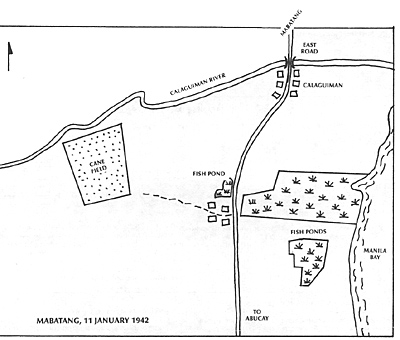The first major battle for Bataan occurred along the Abucay Line, the initial main line of resistance for the Filamerican forces. Bataan is a peninsula, bisected by steep, mountainous terrain (Marivales Mountains). First class roads do not exist, but two, all-weather gravel roads run along the east and west coasts (the East and West Road respectively, of course!). Numerous minor but significant rivers run into Manila Bay (to the east) and the China Sea (to the west).
South of the village and small port of Samal, the 57th Infantry (PS) set up a defensive line with two battalions up front and one back. The small barrio of Mabatang was just to their right front. The entire position extended about 1,300 yards. Tied into the Scouts' left flank was the 21st Regiment (PA).
The ground was for the most part open. The Scouts' right flank was protected by Manila Bay and a series of diked fishponds. The Calaguiman River was about 500yards to the front of their position. The only covered approach to their area was an uncut sugarcane field (about 500 by 750 yards) which came to within one hundred yards of the front line. Requests to burn or cut down the field were denied by II Corps Headquarters. Artillery did however register on the field. A dry creek bed just north of the cane field was also registered as this was, and indeed turned out to be an assembly area of the 65th Brigade.
The Japanese 65th Brigade ("Summer Brigade") under MG Nara had just completed a grueling march. Now, reinforced by the 9th Regiment (116th Infantry Division), large quantities of artillery, and the 7th Tank Regiment (its move slowed by the poor state of the roads), the Brigade approached from the north, roughly parallel to the East Road. The Brigade approached in two regimental columns of battalions. Heavy artillery followed. Somewhere behind them were the lead elements of the 7th Tank. The Japanese Command (Gen. Homma) intended to rupture the Filamerican line at this point.
Fortunately, the Scouts and the 21st had time to dig in and prepare and the II Corps realizing the importance of the position, had placed several batteries of 155s in general support. With two battalions of 75s in direct support, the plenty of time to register them, the Filamerican force had an even chance of beating the Japanese.
ORDERS OF BATTLE
(NOTE: The actual TOEs appear earlier in this article.)
Filamerican Force at Mabatang
57th Infantry (PS), with one battery of the 24th FA (75L28) indirectly attached. In direct support: 1/24th FA (-), two batteries; 2/88th FA, two batteries. Offboard in general support: 86th Artilery (1551-39), three batteries; 301st Artillery (1551-39), four batteries.
Japanese Forces
65th Brigade (+); 9th Infantry Regiment; Two battalions (2nd/3rd) of the 48th Field Artillery (75L21); 1st and 8th Independent Heavy Field Artillery Regiments (105L24); 9th Independent Heavy Artillery Battalion (150L22); 7th Tank Regiment, somewhere off board.
SPECIAL RULES
1. Allow Filamerican forces to be dug-in and wired.
2. Off board artillery support must be requested by the battalion through 57th Regiment headquarters.
3. (Optional) Historically, a lucky 155 hit on the headquarters of the Japanese artillery commander totally disrupted the fire support communications channels, leading to very slow response time. This can be duplicated by requiring 2 to 3 turns to pass between an artillery request to the time of firing.
4. (Optional) Roll a ten-sided die and add three (D10+3) to determine when, if ever, the 7th Tank Regiment will enter the board.
CONCLUSION
Bataan was a great military defeat for the Allies in World War II, yet a victory also. By holding out for six months, they delayed the consolidation of the early Japanese conquests, buying invaluable time for MacArthur to muster his forces and fulfill his promise. Three years were to pass before that would occur but in the meantime, the gallant Filipinos were to organize a great guerrilla army, at times led by Americans who escaped the surrender of Bataan, which was able to tie down large Japanese forces that could have been used more profitably elsewhere.

WWII Philippine Campaign
- Historical Introduction
Wargame Organization: Fila American
Wargame Organization: Japanese
Scenario: Scouts at Mabatang
Back to Table of Contents -- Courier #56
To Courier List of Issues
To MagWeb Master Magazine List
© Copyright 1991 by The Courier Publishing Company.
This article appears in MagWeb (Magazine Web) on the Internet World Wide Web.
Other articles from military history and related magazines are available at http://www.magweb.com